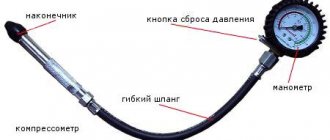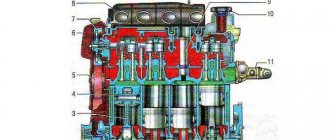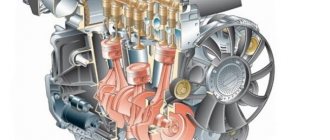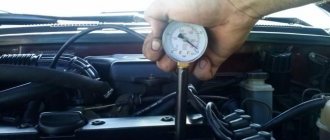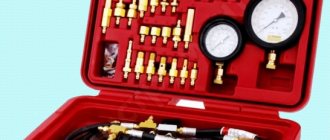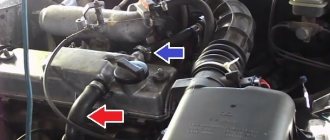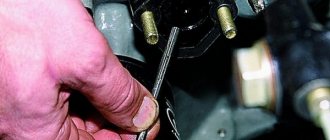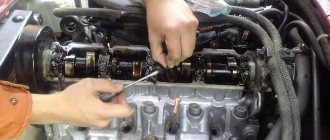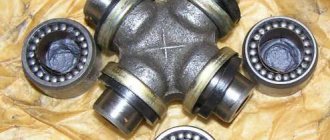07/19/2021 7,344 VAZ 2106
Author: Ivan Baranov
During the operation of a car, sometimes it becomes necessary to measure the compression in the engine cylinders. Typically, such a need arises during diagnostics if there is a suspicion of a malfunction of the piston group. The article discusses what the VAZ 2106 compression is and how it is measured.
[Hide]
VESKO-TRANS.RU
AutoNews / Reviews / Tests
How to Check Engine Compression of a VAZ 2106
Compression in the engine of a VAZ 2106
Considering that more than 4 million units of VAZ 2106 cars were produced, there are many more of them on our roads. Accordingly, the issue of repairing the famous “classic” still remains relevant. For example, the question of what type of compression should a running Six engine support.
The concept of compression, its measurement
The technical data specified in the vehicle's operating manual does not contain such a function. There is a slightly different concept of compression ratio. There is no direct correlation between the two parameters, they are interconnected by only one, in both cases we are talking about pressure.
- The compression ratio is a calculated constant and has no dimensional units. For the VAZ 2106 and its modifications this is 8.5. This figure is the result of dividing the total displacement of the cylinder by the volume of the combustion chamber. Simply put, the air-fuel mixture entering the cylinder is compressed 8.5 times, moving the piston upward.
- Compression is variable; its value depends on the technical condition in which the engine is located. This parameter indicates how much pressure appears in each cylinder when the crankshaft rotates with the starter. This is determined by a pressure gauge that is screwed in instead of spark plugs; the unit of measurement is 1 kgf/cm2 or 1 bar, which is almost identical (1 kgf/cm2 - 0.98 bar).
compression is measured to find the degree of wear of the piston group of cylinders. Its values were obtained experimentally in practice. Curing occurs as follows: all 4 spark plugs are removed and the check valve is rotated in place in each cylinder, and the maximum pressure that can be applied by each piston is determined by rotation through the starter. The VAZ 2106 engine has an impeccable figure of 13 kgf / cm 2, but this is a rare case, such pressure is found on new, only running engines.
Pressure measurements
We have already answered what the normal compression for a VAZ 2114 should be. Now let's look at how to actually measure it? First we need a special device called a compression meter.
All measurements using it are performed in the following order:
- Fully charge the battery.
- Warm up the engine to 75-90 degrees. WITH.
- After the engine warms up, remove all spark plugs.
- Disconnect the fuel supply hose.
- Insert the measuring device into the first spark plug hole.
- Press the gas pedal and hold it (to do this, two people need to take measurements).
- Start the starter and turn the crankshaft with it.
- Wait until the readings on the dial (monitor) of the device reach the maximum - this will be the compression value in a particular cylinder.
- Move the compression gauge to another spark plug hole and continue measurements.
After the pressure is measured in all cylinders, conclusions can be drawn about the general condition of the engine and the need for its repair/restoration.
If the compression is not normal, then you should stop driving the car and try to solve this problem first. Otherwise (especially if the pressure is very high), the engine may completely fail, after which it will need to be completely restored.
The procedure for measuring compression in a VAZ 2106 engine
Before you begin this procedure, you first need to remove all the spark plugs, having first disconnected all the high-voltage wires:
After this, we remove the central wire from the ignition coil so that the current does not approach the wires during starter operation.
Next, screw the fitting of the device into the spark plug hole of the first cylinder. Clearly demonstrated in the photo below:
It is better to turn off the fuel supply during the measurement, and this can be done by disconnecting the fuel hose after the fuel filter.
We will also need an assistant for this work. One person holds the device more tightly in his hands, as it can jump out when the starter starts. And the second person at this time fully depresses the gas pedal and turns the starter with the ignition key. It is necessary to twist until the readings of the device stop increasing, and it is quite sufficient to make 4 compression strokes.
As you can see on my VAZ 2106, the compression in the cylinders is 11 atmospheres in each cylinder. This indicator is considered very good. If the level is below 10, you need to pay attention to the condition of the engine. For a new, well-run-in engine, compression should be within 12 atmospheres.
After checking in one cylinder, do not forget to reset the compression gauge by pressing the pressure release button, otherwise you may get hit in the forehead by the fitting while unscrewing.
Source
Measuring cylinder pressure without a compression gauge
Some motorists are wondering whether it is possible to check whether the compression in a VAZ 2114 8-valve engine is normal or not, without using special instruments.
The answer is yes. True, the results of such a measurement will not be accurate, but relative.
In order to check the condition of the cylinders without a compression gauge, you will need to remove all the spark plugs from the cylinders except one, which will be tested. Then you should manually turn the crankshaft. Then repeat a similar operation with the remaining three cylinders. Subjective sensations about the ease of rotation will be the result.
If, when testing one of the cylinders, the crankshaft rotates too easily, then this cylinder has reduced compression and significant wear. This can be confirmed or refuted by injecting a small amount of oil into the cylinder using a syringe.
If after this you have to rotate the crankshaft with significantly greater force, it means that the walls of the cylinder or piston have significant wear (since the oil has filled the gap and increased compression).
You can try to solve the compression problem on your own using one of the following methods: adjust the valves, decarbonize the engine (this will help remove carbon deposits that have settled on the walls) or replace the oil rings with new ones. If all these operations did not help, and the compression is still not up to standard, then the engine is seriously worn out and must be overhauled.
What compression should be on a VAZ 2101
What should be the compression of a VAZ 2101 engine?
VAZ 2101 | Engine Compression | Lada
If over time you feel that your engine is becoming more lively at first, the loss of power may be due to mechanical wear and tear. More common causes are the greatest wear and tear on worn pistons and cylinders. piston rings , leaking or burning valves, head gasket or spark plug. At the end of the compression stroke, the highest compression pressure is created, which subsequently increases during the avalanche-like combustion of the air-fuel mixture. For pistons and piston rings, cylinder walls, valves, valve seats, valve seals and cylinder head gaskets this means higher thermal and mechanical stress. As a rule, low-power engines already indicate their technical condition in advance. Symptoms include erratic cold starting behavior or rough engine operation, increased oil and fuel consumption, white or blue exhaust, high coolant temperature, poor exhaust performance, and decreased engine power. To get a clear image, you need to check the compression every second visit to the service center. This applies equally to diesel engines.
Compression reference values
Compression values for your vehicle vary slightly depending on the compression ratio. Presented in the table. 4.2. The reference values are valid for engines in excellent technical condition. When analyzing compression, great importance is placed not on the absolute highest performance, but on the same performance in all cylinders. Deviations up to a maximum of 2 bar are allowed. If the deviation exceeds the permissible value, then you need to find out the reason for the deviation. As a first step, your specialist will advise you to measure your pressure loss.
Older engines produce less compression
In older engines, compression is significantly reduced, and this is normal due to normal engine wear. So there is no particular cause for concern, it depends less on the absolute value of the maximum pressure and more on the same values in all cylinders. Only when the measured values have reached the maximum permissible values should it be necessary to think about future repair of the engine or replacing it with another one. If the difference in values exceeds 3 bars, practice shows the following:
— wear of pistons or piston rings;
— jamming of worn piston rings in the piston grooves, caused by the deposition of combustion products;
— damage to the working surfaces of the cylinders due to slight jamming of the pistons or jamming of the piston rings;
— residues of combustion products and oil in the form of deposits on the valve mechanism or on the working surfaces of the valve seat;
— valve burnout due to insufficient valve clearance or thermal overload.
Compression can be measured independently. First of all, you need a helper to rotate the crankshaft with the starter and pressure gauge. In well-equipped workshops, a compression tester is one of the main tools. First, remove all spark plugs from the head (diesel fuel injectors) cylinder block and make sure the valve clearance is adjusted correctly. The assistant at the checkout should Fully press the clutch pedal and accelerator, you check the compression in each cylinder using the device. Since diesel engines consume the same amount of air at all times, you don't need to press the accelerator pedal. Measurements start with the first cylinder and then are measured sequentially in all other cylinders. Consider the crankshaft speed before applying maximum pressure. This number will become the criterion for the following cylinders: the faster the compression is built, the healthier your engine. In a “healthy” engine, compression should be created after 6-8 crankshaft revolutions.
A reliable starter and a fully charged battery are the basis for reliable measurements.
Although this is a basic truth, we still remind you once again - the basis for measurement is a starter with a good clutch and a fully charged battery. If the crankshaft rotates very slowly, the compression in the cylinder is also slow - the compression measurement becomes meaningless. If you have large differences in your measurements, perform a pressure drop test. Using a compression measuring device requires some experience, so we recommend that a professional perform a compression test.
Compression rate
The compression (pressure) indicator plays an important role in detecting faults in the VAZ 2106 engine without disassembling it. The word compression in Latin means compression. Compression refers to the pressure in the cylinders at the extreme point of the compression stroke. A significant decrease in pressure indicates wear on the piston rings of the cylinders, as well as the cylinders themselves. If the valve clearances are incorrectly adjusted, the required amount of air does not enter the combustion chamber.
If compression is low, engine response decreases and fuel and oil consumption increases. With low cylinder pressure, engine power drops and the car cannot reach maximum speed. What compression is needed is indicated in special manuals for measuring it. The average compression rate for a gasoline engine is 9.5 - 10 atmospheres. In this case, the difference between the pressures in each of the cylinders should not exceed 10%.
Engine compartment of VAZ 2106
The following factors may affect the maximum cylinder pressure:
Diagnostics are performed when engine power decreases and when repairing the cylinder head or overhauling the cylinder block.
